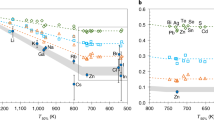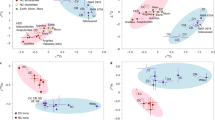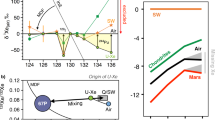Abstract
RASOOL and Le Sergeant1 adopted the inhomogeneous accretion model for planets discussed by Turekian and Clark2 and considered the question of whether carbonaceous chondrites or LL chondrites could better explain the relative abundances of volatile elements found on Earth and Mars. In the inhomogeneous accretion model the volatile elements of the terrestrial planets are attributed to a component which is added late in the accretional history of the planet. Turekian and Clark2 presumed this late-stage component to be like carbonaceous chondrites. But, Rasool and Le Sergeant1 compared the relative concentrations of H, C, N, Ne, Ar, Kr, and Xe (normalised to C) for the Earth, C1 (carbonaceous) chondrites, and LL (ordinary) chondrites and concluded that relative volatile abundances for the Earth have greater similarity to LL chondrites than to C1 chondrites. Specifically, these authors noted that relative to carbon, abundances of the noble gases (Ne, Ar, Kr, and Xe) are within a factor of 3.8 for the Earth and LL chondrites, but differ by factors of 15–37 between the Earth and C1 chondrites. Abundances of H and N relative to C were indicated to be the same within a factor of 2.5 for both meteorite types and the Earth. Turekian and Clark2 had previously made similar comparisons between the Earth and C1 chondrites and concluded that terrestrial volatiles were acquired from material having H/N/C ratios similar to C1 chondrites, but with order-of-magnitude higher abundances of the noble gases. Rasool and Le Sergeant, on the other hand, concluded that volatiles on Earth and, by extention of their arguments, also volatiles on Mars can better be explained by late accretion of material similar to LL chondrites rather than material similar to C1 chondrites. We disagree with the conclusion reached by Rasool and Le Sergeant and with the LL-chondrite data which they used to reach their conclusion. Our purpose here is to demonstrate (1) that the noble gas/C and noble gas/N ratios presently determined for the Earth differ by an order of magnitude from these ratios in most meteorites; (2) that as a group LL chondrites show no better agreement with the Earth in these ratios than do C1 chondrites; (3) data are too incomplete to lead to any conclusions about the type of meteoritic material which may have supplied volatiles to Mars. In addition we suggest that the noble gas/C and noble gas/N ratios for Venus are likely to be more like the Earth's than like meteorites.
This is a preview of subscription content, access via your institution
Access options
Subscribe to this journal
Receive 51 print issues and online access
$199.00 per year
only $3.90 per issue
Buy this article
- Purchase on Springer Link
- Instant access to full article PDF
Prices may be subject to local taxes which are calculated during checkout
Similar content being viewed by others
References
Rasool, S. I. & Le Sergeant, L. Nature 266, 822–823 (1977).
Turekian, K. K. & Clark, S. P. J. atmos. Sci. 32, 1257–1261 (1975).
Lewis, R. S., Gros, Jacques, & Anders, E. J. geophys. Res. 82, 779–792 (1977).
Cameron, A. G. W. in Origin and Distribution of the Elements (ed. Ahrens, L. H.) 125–143 (Pergamon, London, 1968).
Owen, T. & Biemann, K. Science 193, 801–803 (1976).
Zähringer, J. Geochem. cosmochim. Acta 32, 209–237 (1968).
Mazor, E., Heymann, D. & Anders, E. Geochim. cosmochim. Acta 34, 781–824 (1970).
Bogard, D. D., Huneke, J. C., Burnett, D. S. & Wasserburg, G. J. Geochem. cosmochim. Acta 35, 1231–1254 (1971).
Bogard, D. D., Gibson, E. K. Jr., Moore, D. R., Turner, N. L. & Wilkin, R. B. Geochim. cosmochim. Acta 37, 547–558 (1973).
Heymann, D. & Mazor, E. Geochim. cosmochim. Acta 32, 1–20 (1968).
Clayton, R. N., Onuma, N. & Mayeda, T. K. Earth planet. Sci. Lett. 30, 10–18 (1976).
Vdovykin, G. P. & Moore, C. B. in Handbook of Elemental Abundances in Meteorites (ed. Mason, B.) 81–91 (Gordon and Breach, London, 1971).
Heymann, D. in Handbook of Elemental Abundances in Meteorites, (ed. Mason, B.) 29–66 (Gordon and Breach, London, 1971).
Fanale, F. P. Icarus 28, 179–202 (1976).
McElory, M. B., Yung, Y. L. & Nier, A. O. Science 194, 70–72 (1976).
Biemann, K., Owen, T., Rushneck, D. R., La Fleur, A. L. & Howarth, D. W. Science 194, 76–78 (1976).
Hamano, Y. Nature 266, 41–42 (1977).
Surkov, Y. A. Proc. Lunar Science Conf. 8, 2665–2689 (1977).
Avduevsky, V. S. et al. 19th Plenary Meeting of COSPAR, Philadelphia, Pennsylvania June, 1976, 427 (1976).
Malin, M. C. & Sanders, R. S. Science 196, 987–990 (1977).
Schonfeld, Ernest Proc. 5th Lunar Sci. Conf. 1135–1145 (Lunar Science Institute, Houston, Texas, 1974).
Gibson, E. K., Moore, C. B. & Lewis, C. F. Geochim. cosmochim. Acta 35, 599–604 (1971).
Kung, C. C. thesis, Univ. Chicago (1977).
Goles, G. G. in Handbook of Elemental Abundances in Meteorites, (ed. Mason, B.) 149–169 (Gordon and Breach, London, 1971).
Moore, C. B. & Lewis, C. F. J. geophys. Res. 72, 6289–6292 (1967).
Otting, W. & Zähringer, J. Geochim. cosmochim. Acta 31, 1949–1960 (1967).
Srinivason, B., Gros, J. & Anders, E. J. geophys. Res. 82, 762–778 (1977).
Author information
Authors and Affiliations
Rights and permissions
About this article
Cite this article
BOGARD, D., GIBSON, E. The origin and relative abundances of C, N and the noble gases on the terrestrial planets and in meteorites. Nature 271, 150–153 (1978). https://doi.org/10.1038/271150a0
Received:
Accepted:
Issue Date:
DOI: https://doi.org/10.1038/271150a0
Comments
By submitting a comment you agree to abide by our Terms and Community Guidelines. If you find something abusive or that does not comply with our terms or guidelines please flag it as inappropriate.



